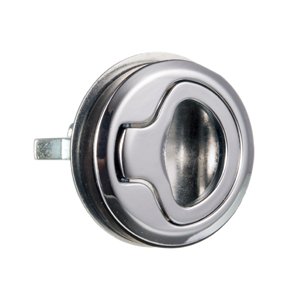In industries where equipment operates under extreme conditions—such as aerospace, automotive, marine, and industrial manufacturing—the reliability of mechanical components is paramount. Latches, which secure panels, doors, or enclosures, must withstand vibrations, shocks, and dynamic loads without compromising functionality. Anti-vibration and shockproof latch designs have emerged as critical solutions to ensure safety, durability, and performance in these challenging environments. This article explores the principles, materials, design strategies, and applications of anti-vibration and shockproof latches, providing a comprehensive overview of their engineering and practical significance.
The Importance of Anti-Vibration and Shockproof Latches
Vibrations and shocks are common in environments where machinery operates continuously or where external forces, such as turbulence or impacts, are frequent. These forces can cause standard latches to loosen, wear prematurely, or fail entirely, leading to equipment downtime, safety hazards, or costly repairs. Anti-vibration and shockproof latches are engineered to mitigate these risks by maintaining secure fastening under dynamic conditions. Their importance lies in:
- Turvallisuus: Preventing unintended openings that could expose sensitive components or endanger personnel.
- Kestävyys: Extending the lifespan of equipment by reducing wear and fatigue.
- Luotettavuus: Ensuring consistent performance in harsh environments, such as high-speed vehicles or heavy machinery.
- Cost Efficiency: Minimizing maintenance and replacement costs through robust design.
Understanding Vibrations and Shocks
To design effective anti-vibration and shockproof latches, engineers must first understand the nature of the forces involved:
- Vibrations: These are oscillatory motions, often repetitive, caused by rotating machinery, engines, or environmental factors like wind or waves. Vibrations are characterized by frequency (Hz), amplitude, and duration. Low-frequency vibrations (e.g., in heavy machinery) and high-frequency vibrations (e.g., in aircraft) require different damping strategies.
- Shocks: These are sudden, high-magnitude forces, such as those caused by impacts, drops, or explosions. Shocks are typically transient but can exert extreme stress on mechanical components.
Latches must counteract both the sustained cyclical stress of vibrations and the instantaneous peak loads of shocks. This dual requirement drives the development of specialized designs and materials.
Key Design Principles for Anti-Vibration and Shockproof Latches
Creating latches that resist vibrations and shocks involves a combination of mechanical design, material selection, and innovative engineering techniques. Below are the core principles guiding their development:
1. Positive Locking Mechanisms
Positive locking ensures that the latch remains securely engaged, even under dynamic loads. Unlike friction-based latches, which rely on surface contact and can loosen over time, positive locking mechanisms use physical barriers, such as detents, cams, or spring-loaded pins, to prevent unintended disengagement. Examples include:
- Pawl Latches: These use a rotating pawl that engages with a catch, providing a secure lock that resists vibrational loosening.
- Puristussalvat: These apply compressive force to the mating surfaces, enhancing stability and sealing against vibrations.
- Over-Center Latches: These use a lever mechanism that locks into a stable position, resisting external forces.
2. Damping and Energy Absorption
To mitigate vibrations, latches incorporate damping elements that absorb and dissipate energy. Common approaches include:
- Elastomeric Components: Rubber or silicone inserts act as vibration dampers, reducing the transmission of oscillatory forces.
- Spring Systems: Springs can absorb shocks by distributing impact energy over a longer duration, reducing peak loads.
- Viscoelastic Materials: These materials exhibit both viscous and elastic properties, effectively dissipating vibrational energy.
3. High-Strength Materials
The choice of material is critical for withstanding shocks and prolonged vibrations. Common materials include:
- Ruostumaton teräs: Offers excellent strength, corrosion resistance, and fatigue life, ideal for marine and aerospace applications.
- Aluminum Alloys: Lightweight yet strong, used in applications where weight reduction is critical, such as automotive and aviation.
- Engineering Plastics: High-performance polymers like polyamide or PEEK provide vibration damping and resistance to fatigue.
- Komposiittimateriaalit: Carbon fiber or glass-reinforced composites offer a balance of strength, weight, and vibration resistance.
4. Low-Friction and Wear-Resistant Surfaces
Vibrations can accelerate wear at contact points, leading to loosening or failure. To counter this, latches are designed with low-friction coatings (e.g., PTFE or Teflon) or self-lubricating materials. Additionally, wear-resistant surfaces, such as hardened steel or ceramic coatings, extend service life.
5. Adjustable Preload and Tension
Latches with adjustable preload allow engineers to fine-tune the clamping force, ensuring a tight fit that resists vibrations. This is particularly useful in applications where thermal expansion or material creep could otherwise loosen the latch.
6. Redundancy and Fail-Safe Features
In critical applications, such as aerospace or medical equipment, latches may incorporate redundant locking mechanisms or fail-safe designs to ensure they remain secure even if one component fails. For example, a secondary catch or a backup spring can prevent catastrophic failure.
Types of Anti-Vibration and Shockproof Latches
Several latch designs have been developed to address specific vibration and shock challenges. Below are some of the most common types:
1. Draw Latches
Draw latches use a tensioning mechanism to pull two surfaces together tightly. Their over-center design ensures that the latch remains locked under vibration. They are widely used in industrial enclosures and transportation cases.
2. Pyörivät salvat
Rotary latches feature a rotating catch that engages with a striker, providing a secure lock. Their compact design and resistance to vibrational loosening make them popular in automotive and aerospace applications.
3. Slam salvat
Slam latches automatically engage when a door or panel is closed, requiring no manual activation. They are designed with internal springs or dampers to absorb shocks, making them suitable for rugged environments like off-road vehicles.
4. Vibration-Isolated Latches
These latches incorporate elastomeric or spring-based isolators to decouple the latch from the vibrating structure. They are commonly used in electronics enclosures, where sensitive components must be protected from vibrations.
5. Magnetic Latches
Magnetic latches use strong magnets to maintain closure. While not suitable for high-shock environments, they can be effective for low-vibration applications, such as cabinetry or lightweight panels.
Material Selection and Manufacturing Considerations
The performance of anti-vibration and shockproof latches depends heavily on material selection and manufacturing precision. Key considerations include:
- Fatigue Resistance: Materials must withstand repeated loading cycles without cracking or deforming. Stainless steel and titanium are often chosen for their high fatigue strength.
- Korroosionkestävyys: In marine or chemical environments, latches must resist rust and degradation. Stainless steel, anodized aluminum, or coated alloys are preferred.
- Weight: In aerospace and automotive applications, lightweight materials like aluminum or composites reduce overall system weight.
- Manufacturing Tolerances: Tight tolerances ensure that latches engage securely and resist loosening. CNC machining, injection molding, or additive manufacturing may be used to achieve precision.
Advanced manufacturing techniques, such as 3D printing, allow for the creation of complex geometries, such as integrated damping features or lightweight lattice structures, that enhance latch performance.
Applications of Anti-Vibration and Shockproof Latches
Anti-vibration and shockproof latches are used across a wide range of industries, each with unique requirements:
1. Ilmailu- ja avaruusala
In aircraft and spacecraft, latches secure access panels, cargo compartments, and avionics enclosures. They must withstand high-frequency vibrations from engines and shocks from turbulence or landings. Lightweight, corrosion-resistant materials like aluminum and titanium are commonly used.
2. Autoteollisuus
In vehicles, especially off-road or heavy-duty trucks, latches secure hoods, tailgates, and storage compartments. They must endure road vibrations, temperature fluctuations, and occasional impacts. Stainless steel and engineering plastics are popular choices.
3. Marine
Marine latches face constant vibrations from engines and waves, as well as corrosive saltwater exposure. Stainless steel or composite latches with sealed designs are critical for hatches, lockers, and equipment enclosures.
4. Industrial Machinery
Heavy machinery, such as construction equipment or factory robots, generates intense vibrations. Latches for maintenance panels or safety guards must be robust and easy to operate, often using draw or compression designs.
5. Electronics and Telecommunications
Sensitive electronics, such as servers or telecom equipment, require latches that isolate vibrations to protect internal components. Vibration-isolated latches with elastomeric mounts are commonly used in these applications.
6. Military and Defense
Military vehicles, weapons systems, and portable equipment demand latches that can withstand extreme shocks, such as those from explosions or rough terrain. Redundant locking mechanisms and high-strength materials are essential.
Testaus ja sertifiointi
To ensure reliability, anti-vibration and shockproof latches undergo rigorous testing, including:
- Vibration Testing: Conducted on shake tables to simulate operational conditions, often following standards like MIL-STD-810 or ISO 16750.
- Shock Testing: Involves drop tests or impact simulations to verify performance under sudden loads.
- Fatigue Testing: Assesses the latch’s ability to withstand repeated cycles of stress.
- Environmental Testing: Evaluates resistance to temperature extremes, humidity, and corrosion.
Certifications, such as those from the International Organization for Standardization (ISO) or military standards (MIL-SPEC), provide assurance of a latch’s performance in specific applications.
Challenges in Designing Anti-Vibration and Shockproof Latches
Despite advancements, several challenges remain in latch design:
- Balancing Strength and Weight: Achieving high strength without adding excessive weight is critical in aerospace and automotive applications.
- Cost Constraints: Advanced materials and manufacturing processes can increase costs, limiting adoption in budget-sensitive industries.
- Complex Environments: Latches must perform reliably in diverse conditions, such as extreme temperatures, corrosive environments, or high radiation.
- Helppokäyttöisyys: Latches must be user-friendly, allowing quick access without compromising security.
Future Trends in Latch Design
The evolution of anti-vibration and shockproof latches is driven by technological advancements and industry demands. Emerging trends include:
- Älykkäät salvat: Integrating sensors to monitor latch status, detect vibrations, or predict maintenance needs.
- Additive Manufacturing: Enabling the production of lightweight, complex latch designs with integrated damping features.
- Kestävät materiaalit: Using recyclable or bio-based materials to reduce environmental impact.
- Adaptive Designs: Developing latches that adjust their clamping force dynamically in response to changing conditions.
Case Studies
Case Study 1: Aerospace Panel Latch
An aerospace manufacturer needed a latch for an avionics panel that could withstand vibrations of up to 20 Hz and shocks from emergency landings. Engineers designed a rotary latch with a titanium body and elastomeric dampers. The latch passed MIL-STD-810 testing and reduced maintenance costs by 30% compared to previous designs.
Case Study 2: Off-Road Vehicle Hood Latch
A heavy-duty truck manufacturer required a hood latch that could endure road vibrations and occasional impacts. A compression latch with adjustable preload and stainless steel construction was implemented, improving reliability and reducing warranty claims.
Päätelmä
Anti-vibration and shockproof latch designs are indispensable for ensuring the reliability and safety of equipment in demanding environments. By combining positive locking mechanisms, advanced materials, and innovative damping techniques, these latches address the challenges of vibrations and shocks across industries. As technology advances, the integration of smart features, sustainable materials, and additive manufacturing will further enhance their performance. For engineers and manufacturers, investing in robust latch designs is not just a matter of functionality but a commitment to resilience, safety, and efficiency in the face of dynamic challenges.







